Fiber Optics
For Wireless
Today's users of mobile devices depend
on wireless connections for their voice, data and even
video communications. Even homes and businesses may depend
on wireless, especially those who are not in urban or
suburban areas served by FTTH (fiber to the home) or FTTC
(fiber to the curb.) Some of us in the business now use
the term FTTW for fiber to wireless, since wireless
depends on fiber for the communications backbone and
increasingly the connection to the wireless antennas, no
matter what kinds of wireless we use.
Wireless is not entirely wireless. The
easiest way to understand wireless is to think of it as a
link that replaces the cable that connects your cellular
or wireless phone to the phone system or the
patchcord that connects your computer or other portable
Internet device to the network. To understand wireless, it
is necessary to look at several different and unique types
of wireless systems, including cellular wireless phones,
wireless in premises cabling, municipal or private
wireless links and even some of the short distance links
used for computer peripheral connections.
Cellular Wireless
Cellular phone systems have grown to dominate
the telecommunications marketplace. Countries that have
had extensive landline phone systems for a century now
already have more cell phones than land lines. Countries
that had not developed landline-based phone networks
skipped them entirely and went directly to cellular
wireless where the adoption rates have been extremely
high.
While cellular wireless started out as a
voice network, text messaging became very popular,
eclipsing voice for most users. Smart phones brought the
Internet to the phone, and soon data became the largest
traffic generator for cellular networks. In the first 10
years of the iPhone, AT&T claimed their data traffic
grew 80000% - 800 times! Now video is coming to these same
devices, creating an even faster growth rate for cellular
network traffic.

To accommodate this traffic level, wireless
needs new systems with more radio frequency spectrum.
Current systems (CDMA for some systems, in the US, GSM for
the rest of the US and the world) are evolving into new
generations of systems (4G, LTE and the future 5G) that
have more data bandwidth. Almost from the beginning,
cellular towers were connected to the telco networks over
fiber optics, just like any other connection.
Wireless towers have small huts at the base that connect
to fiber backbones that connect towers to the various
phone companies. As traffic grows, towers need more
antennas. Instead of 3-4 antennas on a tower, now one sees
dozens, so towers and buildings now look like this:
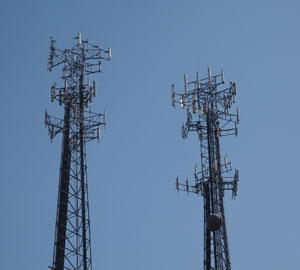
or on buildings

To provide the bandwidth needed to the tower or cell site,
fiber is being used to connect the towers to the phone
systems. The connection to the tower is generally called
"backhaul."
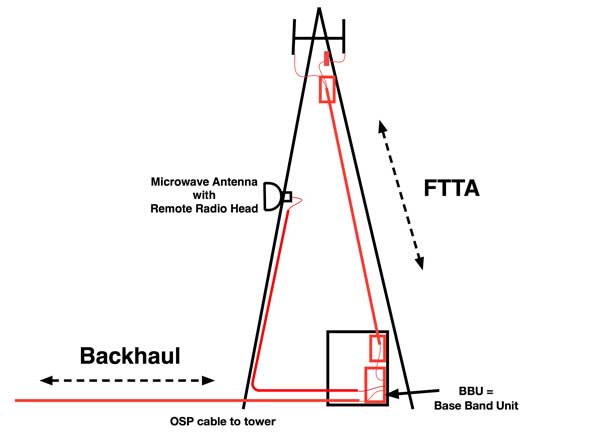
All these antennas on a tower or the side of
a building have created another problem. In the past, each
antenna has been connected by a large (2", 50mm) coax
cable that carries both signal and power to the antenna.
But with all these antennas, the size, weight and even
wind resistance of these cables has become a big problem.
These towers which have been upgraded to add many antennas
show the problem with these large coax cables.
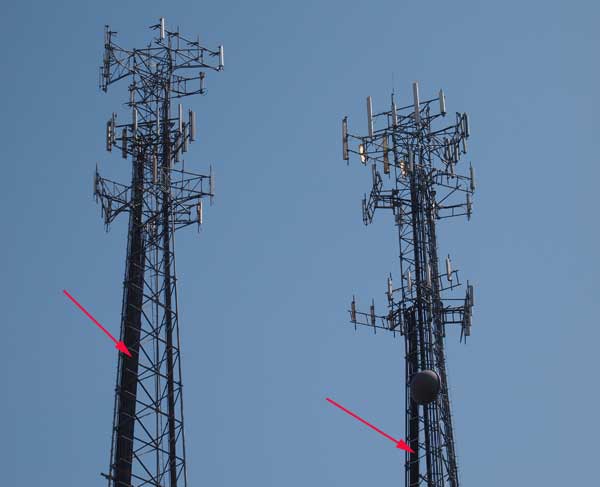
This is another application where copper cable is
being replaced by optical fiber. One small fiber cable can
replace all those coax cables and a separate power cable
is used for the drivers on the antennas. This is called "fiber
to the antenna" or FTTA. These applications use
mostly prefab
cable assemblies since making terminations on top of
the tower is difficult to say the least. Some applications
use prefab at the top of the tower and conventional
termination at the base. Many of these systems use
multimode fiber because the distances are so short and the
transceivers are much less expensive for MM fiber.
Below are photos from Corning showing a remote
antenna head end and antenna and the fiber terminal
serving the antennas. Note the use of a prefab cable
system at the top of the tower, making installation much
easier. Some installations use a composite cable that
includes both fiber and power conductors so only one cable
need be installed up the tower.
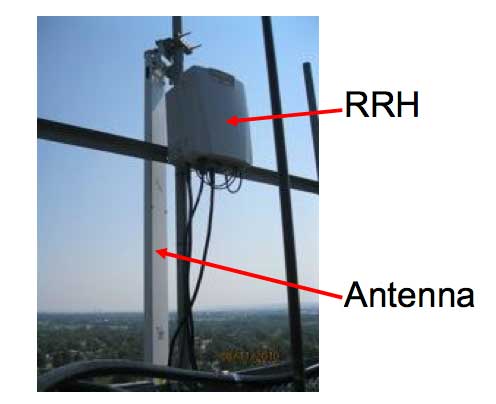
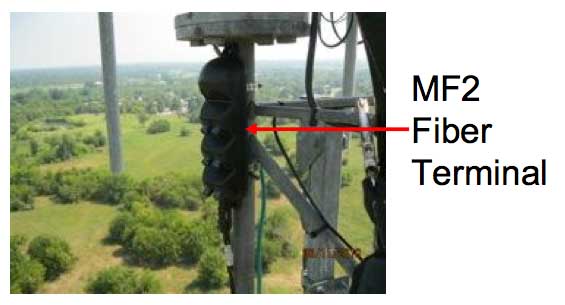
Photos courtesy of Corning.
Many cell towers are independently owned and space
for antennas is rented to the service providers.
Installation of fiber to the towers and fiber up to the
antennas is generally done by independent contractors who
specialize in this kind of work.
The
New FTTA Architecture - "Fronthaul"
The
large amount of activity on wireless means that
technology is being developed to make it faster, more
available and cheaper. One of the interesting
developments is traceable directly to the capabilities
of fiber for long links and high bandwidth. It's
called "fronthaul" by one of the developers, Nokia
(new parent of Lucent.) Fronthaul copies the cabling
architecture of small cells and DAS (see below) into
the outdoor cell site. It replaces backhaul by moving
the electronics (base band unit - BBU) at the cell
tower back to a telco office or head end. at the
tower, you basically leave an active antenna or
passive antenna with remote radio head (RRH) connected
with passive fiber. This move of the electronics to a
head end saves costs, power, maintenance, etc.
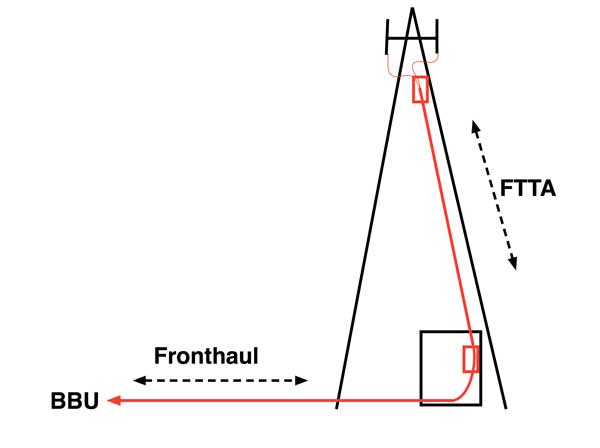
Small Cells
Small
cells go by many names including micro-cells. They are
small integrated radios and antennas intended for small
geographic areas. They can cover the range of 700MHz to
2.6GHz with power outputs from 1-5W, much less than
regular cellular antennas. They are intended to be be
mounted on typical urban fixtures – walls, street
lights, traffic lights, bus stops, whatever gets them
slightly up off the ground. They only need a single
fiber and power to operate. The electronics to control
them is in a CO or head end.
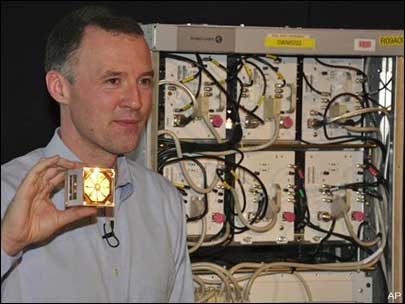
Alcatel-Lucent LightCube Radio Small Cell
Because they cover smaller areas than regular cellular
antennas, they will have fewer users connecting,
spreading out available bandwidth to increase bandwidth
available per user. Most will require only a single SM
fiber and DC power making installation easy where
municipal cable plants are available. Fiber technology
for installations is standard OSP and premises – nothing
new required. We understand they can even use PON
technology to reduce the electronics near the antenna.
You can place several of these small cells in one dome
providing extended coverage over many frequencies.
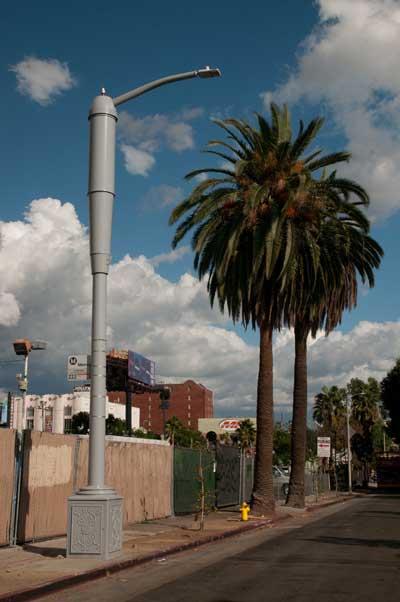
(Phillips)
Small cells are ideal for metro areas where residents
don't like unsightly cell towers. The small cells can be
installed in many locations, but this may become one of
the most popular. This is a "smart street light" in Los
Angeles. It's a product from Phillips which created the
LED street light and Ericsson which added the small
cells which are inside the larger diameter of the light
pole toward the top. Each of these lights require power,
of course, and fiber for the small cells. The cable
architecture is "fronthaul" as described above.
Distributed Antenna
Systems
Wireless traffic is growing at a phenomenal rate. But the
majority of calls originate inside buildings so wireless
coverage inside buildings has become more important.
Cellular wireless often cannot penetrate walls and even
windows in large buildings, so low-power cellular antennas
are placed inside buildings to provide reliable service.
There are several other reasons for cellular systems
inside buildings also. Sometimes the number of users
inside a building like a convention center or sports
facility exceeds the bandwidth of a single cellular system
and local laws specify the need for public safety signal
coverage.
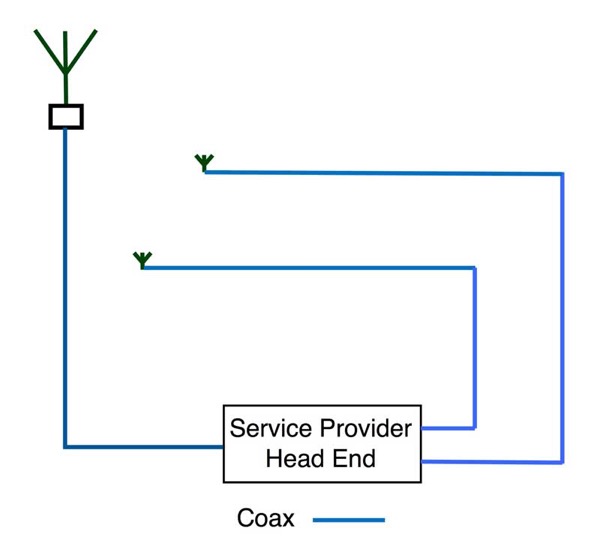
Passive DASs are simply repeaters for signals
to/form an outside antenna. The electronics amplified the
signals and connected remote antennas over large
(12-25mm/0.5-1inch) coax cables. Besides the obvious noise
problems with all analog systems, the coax cable runs were
limited to about 100m (330ft) making this a difficult
system to use in large buildings or structures. Passive
systems have been used mainly in small to medium sized
buildings - ~10,000-200,000 sq ft size but are being
replaced by digital systems.
Today’s solution distributes the signal inside the
building or facility over fiber as digital signals.
(Although there have been some systems that use RF over
fiber inside the building, it’s not common anymore.) A DAS
has to connect to service providers which is done with
fiber backhaul to all the service providers for large
facilities and may be done by wireless antennas on the
building for smaller facilities. Fiber backhaul enhances
service and simplifies installation since coax cabling to
the carrier antenna is not necessary.
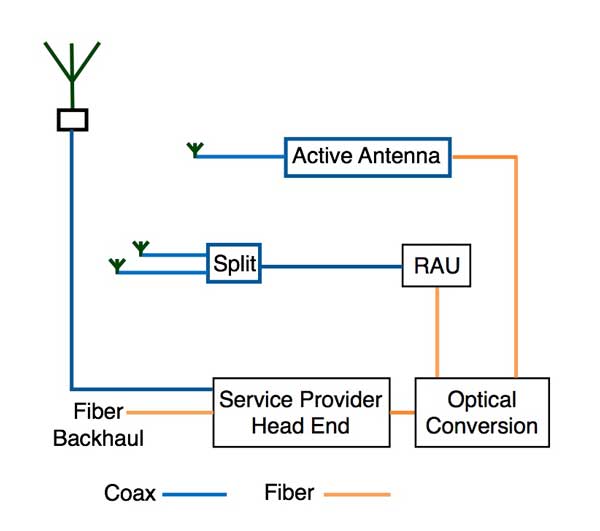
The block diagram here is generic – practically every
manufacturer of DAS systems has different names for the
various operational blocks and even some unique
architectures, even using PONs (passive optical networks)
like OLANs and FTTH. But the idea is to get wireless
signals to numerous remote antennas over fiber, convert to
coax at remote antenna units (RAU) and then distribute to
numerous low-power antennas, often multiples through coax
splitters, covering small areas.
Active DAS systems are used in larger buildings, up to
1milion sq ft.
More
on DAS.
Wireless
In Premises Networks
Wireless in the corporate premises network is
WiFi (IEEE 802.11), the common network built into most
laptop or netbook computers, tablets, VoIP phones, many
cellular phones and other portable devices. The wireless
“antenna” in the network, called an "access point," is a
lot more than that. It’s a radio transceiver and network
adapter that connects to your laptop to allow access to
the network, with some logic that implements part of the
network protocols allowing access to the network. The
transceiver in the antenna has limited power as does the
transceiver in the portable device, so the distance from
the antenna to your laptop is limited. Connection between
devices and antennas can be affected by metal in a
building that reflects or attenuates signals. Signals can
even be absorbed by people in the building. A typical
office building may need 4-8 antennas per floor to get
consistent connections throughout the area.
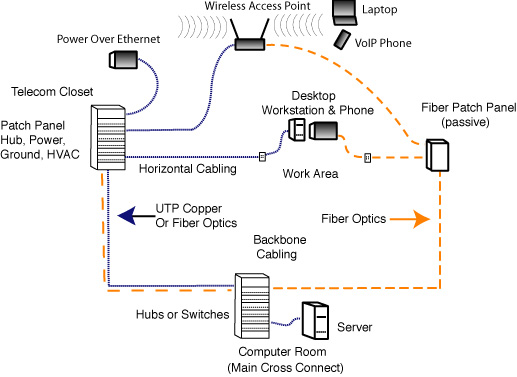
The antenna is connected to the network just like a
PC, using UTP or fiber optic cable to a local switch which
connects it into the network backbone. Not only does the
wireless antenna require a network cable to connect to the
network, but it needs power – uninterruptible power, just
like any network hub or switch – to operate.
So replacing a wired network with a
wireless one doesn’t mean you don’t need cabling; you may
in fact need more when you consider the power needs of the
antennas. Any advantage of a wireless network is not
in the installation, it’s in the flexibility of users
roaming but maintaining connections.
Bluetooth (IEEE 802.15) is a
limited distance network mainly used for consumer devices.
It has been used to connect a wireless printer or mouse to
a PC, wireless headsets to cell phones and stereos, cell
phones to cars for hands-free operation, digital cameras
to printers, etc. In terms of installation, Bluetooth is
built-in to many devices and adapters can be plugged into
USB ports or added as cards to PCs, not installed as
access points like WiFi, so it is not generally of
interest for cabling installers.
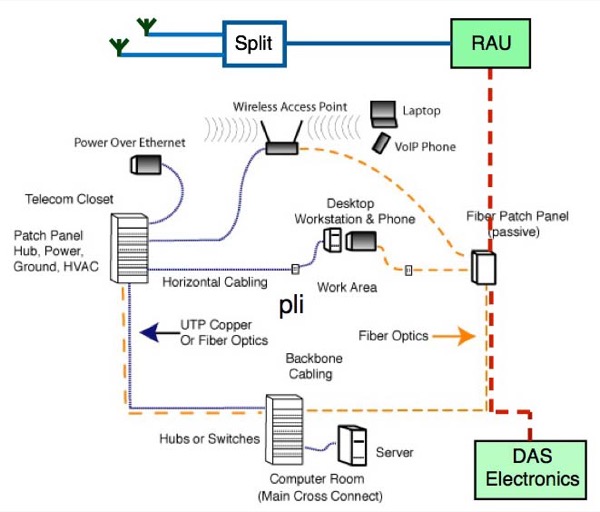
The
architecture of the cabling for a DAS is no different
from an Ethernet LAN or standardized structured cabling.
In some cases, DAS systems can be monitored by network
management software used for LANs.
More
on wireless in premises systems including wireless
network standards .
Metropolitan Wireless
Metropolitan wireless systems have had
a rocky road. Initially, they were proposed as an
inexpensive way of offering broadband to everyone, but
providing support and competitive issues with other
broadband suppliers ended most of these early trials. Now
cities often install WiFi for public service use and free
Internet access in parks and plazas, like these examples.
The distances these access points are from the network
connections require fiber, usually SM fiber available in
the metro fiber network used for other communications.
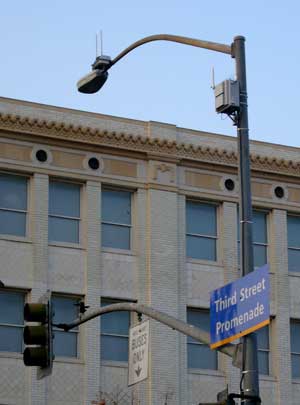
Downtown Santa Monica California, where you can see two
separate systems, one public, one private for city
services, on one pole.
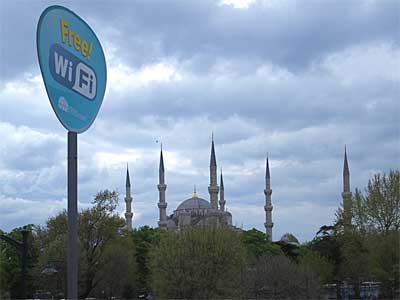
Istanbul, Turkey installed metro WiFi for visitors as the
European City of the Year.
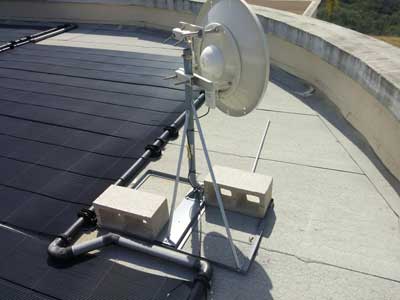
(San
Diego Broadband)
Several
services have offered metro WiFi wireless using line of
sight WiFi connections instead of running fiber between
buildings. This is possible using both licensed and
unlicensed frequencies. The access point or antenna
needs an Internet feed which is going to be fiber in
most cases. Google bought Webpass for their work in this
area. The ISP finds a fiber connected building and
negotiates using their connections and rooftop to serve
other buildings.
Rural WiFi
Rural
wireless works the same way as line of sight metro WiFi.
The wireless Internet service provider runs fiber to a
location where antennas can service as many users as
possible with line of sight connections. The ISP is
often in a small town that has good Internet connections
and a building tall enough for line of sight to local
users. Rural WiFi is widely used in rural areas in
California.
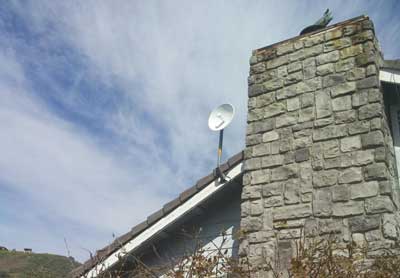
Rural
WiFi antenna on home. (San
Diego Broadband)
Proposed But Not Widely
Accepted
Two wireless standards have been proposed but have not
been widely adopted, WiMAX and Super WiFi.
WiMAX
WiMAX is a further development of wireless network
technology that expands the data capacity of wireless to ~
100 Mb/s and it’s distance capability to several miles.
Unlike WiFi which was primarily a short distance network
aimed at private networks, WiMAX appears aimed at
communications carriers who could use it in place of
landline networks, substituting WiMAX, for example, for
Fiber To The Home, in areas needing upgrades of their
networks or using it to allow notebook PC or PDA roaming
in a metropolitan area.
"Super WiFi" On Fiber
Bringing broadband to the rural areas
of the US or any large country with sparse population can
be very expensive. The US has a plan, however, that may
make it more affordable. "Super WiFi" is not your usual
WiFi. It is using WiFi protocols but broadcasting on
frequencies of unused TV channels, called "white space."
The FCC is ready to open up new frequencies to broadband
to allow delivering broadband Internet and phone to rural
areas where cabling is too expensive.
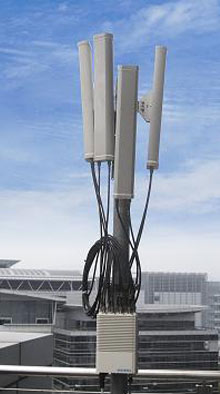 An example
of a super Wi-Fi antenna: Altai
An example
of a super Wi-Fi antenna: Altai
Super WiFi works at a lower frequency than either
regular WiFi or cellular systems so it has more reach into
areas that are too rugged for most wireless systems. Usage
in more urban areas may be a problem however, if there are
too many broadcast TV stations which can interfere with
Super WiFi signals (and vice versa.) These antennas will
also require fiber to connect into the network.
More
in MIT Technology Review
And
the US Government Announcement.
More On Fiber For
Wireless
FTTA- Fiber To The
Antenna
Testing FTTA
Fiber
DAS - Distributed
Antenna Systems
Small Cells
WiFi
- Premises Wireless
Comparing
WiFi, Small Cells and DAS.
FOA
Guide Table of Contents.
|



